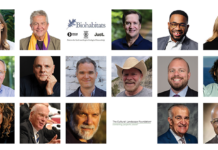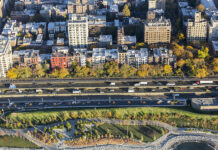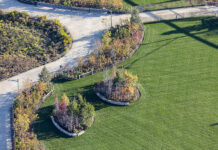The Summer Olympic Games start today! And while still exciting, the COVID-19 pandemic will undoubtedly necessitate a much smaller on-site Olympic crowd this year in Tokyo. Typically, Olympics host cities make giant investments in venues, infrastructure, and green areas to support the thousands of athletes and tourists. But what happens when the Olympics are over? In the best case scenarios, former Olympic Parks, particularly the green areas, become a living legacy for current and future generations of the city’s residents to enjoy. Here are some past Olympic green areas that have succeeded in achieving landscaping gold long after the official sport competitions were over.
Queen Elizabeth Olympic Park 2012

Built for the London 2012 Games and spread across 560 acres of stunning parklands located 10 minutes from central London, the Queen Elizabeth Olympic Park and its buildings have won or been nominated for more than 60 awards. Home to beautifully landscaped gardens, sporting venues, and the ArcelorMittal Orbit visitor attraction, there are four miles of waterways, approximately 26 acres of woods, over 13,000 trees, at least 60 species of birds, and 250 species of insects in the Park. The Park’s free walking trails and unique adventure play areas include rock pools, sand pits, slides, and swings. Popular interactive fountains feature 195 jets of water that put on a show and provide a place to cool off. The Park is also the recipient of multiple Green Flag Awards, an international award for the highest possible environmental standards, beautiful maintenance, and excellent visitor facilities.
Landscape architecture firm Hargreaves Jones led the design for the parklands. It was the largest new park created in Europe for over 150 years. Focused around the restoration of the River Lea, the park includes a northern environmental park and a southern festival park that showcases the Olympic Gardens, which are themed around the countries who participate in the Games.
According to Hargreaves, “The environmental north park converts the channelized industrial canal into a naturalized meandering river corridor with lowland meadows and wetlands, sweeping lawns for gathering, and sculpted banks for viewing. The South Park creates gently terraced river banks and includes the themed Olympic Gardens – a rich and colorful tribute to the plants of the countries that gather for the Games.” A Transformation Plan replaced paving and temporary Olympic sporting venues with a cycle track, outdoor performance area, and additional habitat landscapes. It also connected the park to the surrounding neighborhoods to create a regenerated regional landscape.
Beijing Olympic Forest Park 2008
A multi-award winner, the 1,680-acre Beijing Olympic Forest Park, built for the 2008 Summer Games, is the largest public green space ever constructed in Beijing. According to the project’s Case Study Brief in the Landscape Performance Series by the Landscape Architecture Foundation (LAF): Surrounded by an ultra-urban environment of high-density development and high-volume traffic, the park provides a variety of spaces for visitors including Mount Yangshan, a 50-acre man-made lake; woodlands; wetlands; grasslands; educational facilities; paths; playgrounds; and sports fields. The design, done by Beijing Tsinghua Urban Planning & Design Institute (THUPDI), incorporates traditional Chinese landscape principles with modern ecological concepts to address goals of zero waste and zero stormwater discharge.
The LAF’s case study reports that a 10-acre constructed wetland in the southern part of the park treats 690,000 gallons of reclaimed water per day and recharges manmade Aohai Lake, which is the “dragon head” of the park’s water system. The wetland was designed to have a meandering flow path, an extended water retention time, and a series of cascading landscapes. Various low impact development techniques were employed to retain stormwater on the site, including porous paving, vegetated swales, and retention ponds. (The park survived a 50-year storm in 2011, when many nearby areas were severely flooded.)
Other features cited by LAF’s Landscape Performance Series include:
- By using reclaimed water from the Qinghe Waste Water Treatment Plant for landscape irrigation and to recharge Park water bodies, the Park reduces annual consumption of potable water by 250 million gallons, the equivalent of 380 Olympic-sized swimming pools.
- Different irrigation methods are used for different types of vegetation; spray irrigation is employed in the northern part of the park and drip irrigation in the south. An intelligent irrigation control system helps optimize water use.

- A 197′ wide, 715′ long elevated eco-corridor for pedestrians and wildlife was designed and built across the 262′ wide highway that divides the park.
- More than 2 million plants were installed in the park, including more than 100 tree species and 80 shrub species, along with grassland and wetland species. The trees sequester an estimated 8,735,000 pounds of CO2 annually, equivalent to taking 777 passenger vehicles off the road.
- A 24-meter high swift tower was built to provide a home for more than 1,500 swifts, birds that have lived in Beijing for hundreds of years. In recent decades, the swift population has declined as traditional tower structures are demolished.
- The central heating and cooling system for 21 buildings on the site uses a geothermal pump that transfers heat to and from the ground.

- A solar photovoltaic panel system is used on two symmetric trellis structures, generating 83,000 kWh of electricity per year, or enough to meet the energy needs of 227 China residents for a year, reduce the use of coal by 66,000 pounds, and in turn, reduce emissions. The system powers part of the park and raises public awareness.
- An earth-sheltered building is one of two buildings in the park that provide for research and demonstration of ecological energy-saving techniques. It is partially buried and a skylight system reduces dependence on artificial illumination, saving up to 1063 kWh of electricity every year.

Since completion, the park has become an important public green space that provides recreation, educational opportunities, and environmental benefits to Beijing residents and visitors alike. According to the American Society of Landscape Architects (ASLA) Awards Jury— who gave the project a 2009 Honor Award for General Design, “This project was planned for the Olympics, but planted for the future. The landscape architect had an incredible opportunity to create something astounding on a monumental scale and they took it. This will transform Beijing as Central Park did New York City.” Of note: The Park will be used once again for the 2022 Beijing Winter Olympics.
Olympic Plaza Sydney 2000
Prior to Queen Elizabeth Olympic Park (mentioned above), landscape architecture firm Hargreaves Jones also led the design of the public areas at Homebush Bay, site of the 2000 Sydney Olympics. The centerpiece of the public domain, the .5 mile long Olympic Plaza, tilts slightly from the high point of the site, marked by a participatory fountain (see right) and a grove of mature fig trees transplanted from the site to the low point where the arcing jets and wetlands treat the storm water from the site in a dramatic visual terminus of the plaza. The earth excavated to create the wetlands was formed into a large pyramidal hill from which spectators watched the sun set over the games at the end of each day, and which park goers today still enjoy. The porous paving and structural soil devised for the project, the storm water treatment and re-use for irrigation, along with the dramatic light / shade and solar collection features helped ensure a sustainable future. Of note: the Sydney Olympic Park has been used recently as a major COVID-19 vaccination hub.
and a grove of mature fig trees transplanted from the site to the low point where the arcing jets and wetlands treat the storm water from the site in a dramatic visual terminus of the plaza. The earth excavated to create the wetlands was formed into a large pyramidal hill from which spectators watched the sun set over the games at the end of each day, and which park goers today still enjoy. The porous paving and structural soil devised for the project, the storm water treatment and re-use for irrigation, along with the dramatic light / shade and solar collection features helped ensure a sustainable future. Of note: the Sydney Olympic Park has been used recently as a major COVID-19 vaccination hub.
Centennial Olympic Park Atlanta 1996 
Just this past Monday, July 19, marked the 25th anniversary of the opening of the Centennial Olympic Park in Atlanta, GA, built for the 1996 Summer Olympics. Today, the 22-acre greenspace, overseen by the Georgia World Congress Center Authority, anchors an entertainment and hospitality district and includes a water Fountain of Rings, the iconic Olympic symbol, “The Spectacular,” playgrounds, gardens, and lawns. But that certainly wasn’t the scene back in 1993, when the area was a multi-block eyesore of empty lots and abandoned buildings in the middle of downtown Atlanta (shown right). But Billy Payne, chief executive of the Atlanta Committee for the Olympic Games (ACOG), envisioned a beautiful gathering space for the Olympic Games—and for years to come. And Atlanta responded with an estimated $75 million in development costs entirely from private-sector donations.
But that certainly wasn’t the scene back in 1993, when the area was a multi-block eyesore of empty lots and abandoned buildings in the middle of downtown Atlanta (shown right). But Billy Payne, chief executive of the Atlanta Committee for the Olympic Games (ACOG), envisioned a beautiful gathering space for the Olympic Games—and for years to come. And Atlanta responded with an estimated $75 million in development costs entirely from private-sector donations.  The Park has since received further updates. In 2016, to commemorate the Park’s 20th anniversary, a capital campaign launched to fund improvements completed in 2019. Visitors can experience events at the Southern Company Amphitheater, stroll the water gardens, and enjoy the new Magnolia Tribute Garden, comprised of 29 magnolia trees of seven different varieties placed along a 700-foot paved path. Beyond the Olympics, Centennial Park now stands as the keystone in an area spurring billions of dollars of economic impact and revitalization in Atlanta.
The Park has since received further updates. In 2016, to commemorate the Park’s 20th anniversary, a capital campaign launched to fund improvements completed in 2019. Visitors can experience events at the Southern Company Amphitheater, stroll the water gardens, and enjoy the new Magnolia Tribute Garden, comprised of 29 magnolia trees of seven different varieties placed along a 700-foot paved path. Beyond the Olympics, Centennial Park now stands as the keystone in an area spurring billions of dollars of economic impact and revitalization in Atlanta.
Photo Credits:
Queen Elizabeth Olympic Park & Sydney Olympic Park: Hargreaves Jones
Beijing Olympic Forest Park: Beijing Tsinghua Urban Planning & Design Institute via the Landscape Architecture Foundation; Last photo from Beijing Tsinghua Urban Planning & Design Institute via American Society of Landscape Architects
Atlanta Centennial Olympic Park: Georgia World Congress Center Authority











![[VIDEO] Dickies®: Discover Workwear That’s Anything But Uniform](https://turfmagazine.com/wp-content/uploads/2023/06/1647663814-4b1a2a7742790a9b1e97a3b963477850192e1d6a9dfba9b07214a77bae25d6e3-d-218x150.jpg)





































![[VIDEO] Dickies®: Discover Workwear That’s Anything But Uniform](https://turfmagazine.com/wp-content/uploads/2023/06/1647663814-4b1a2a7742790a9b1e97a3b963477850192e1d6a9dfba9b07214a77bae25d6e3-d-324x160.jpg)